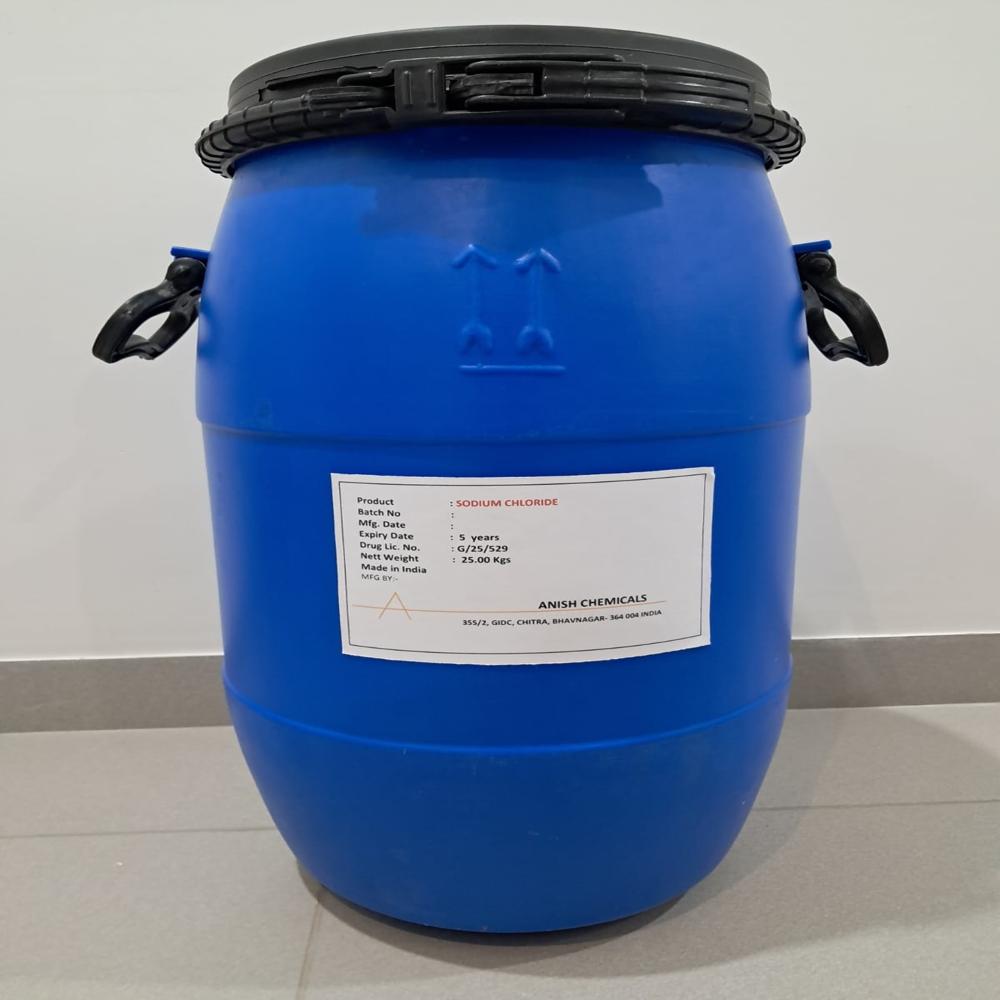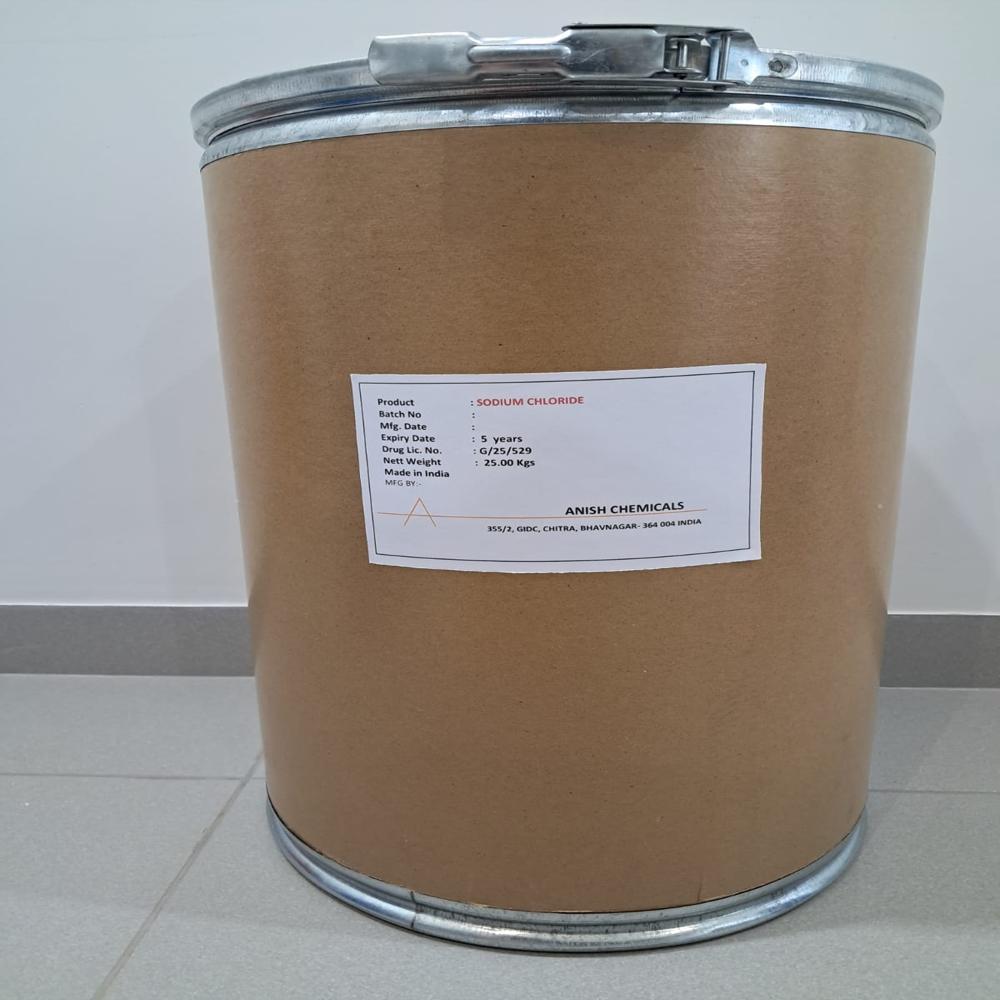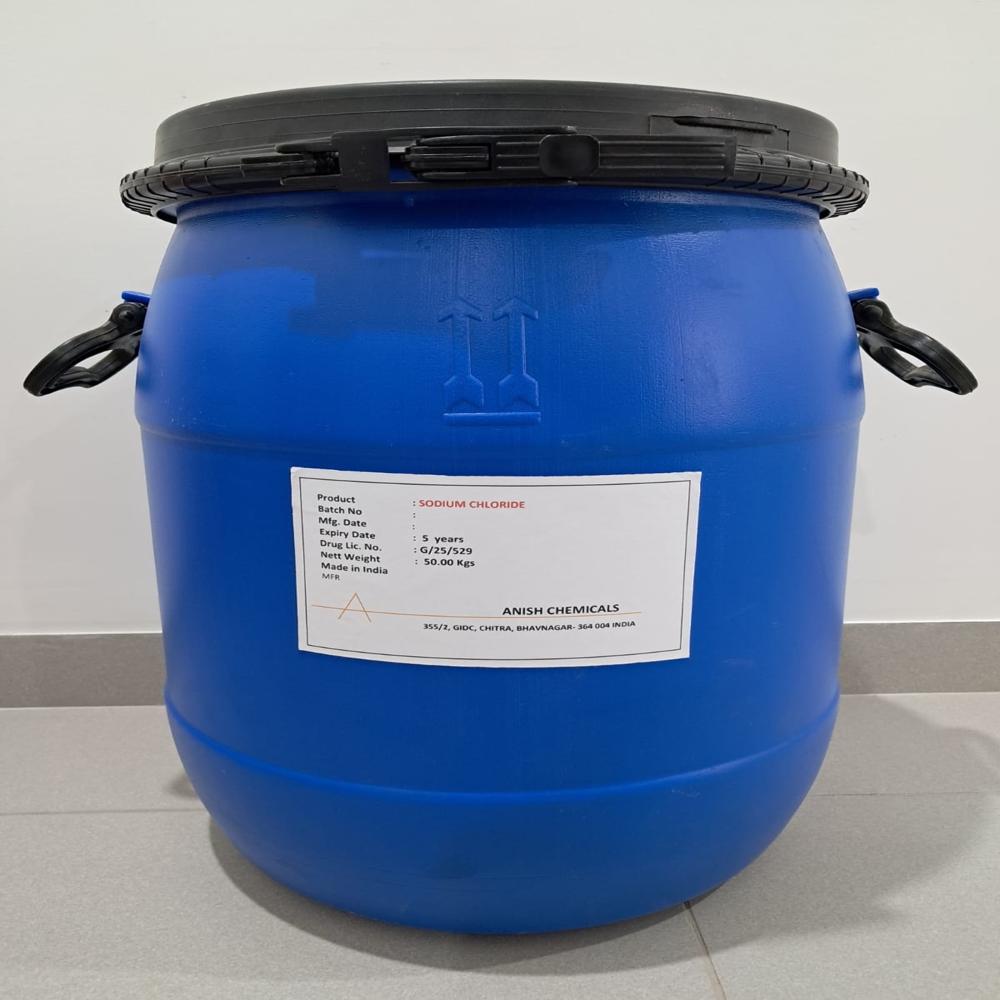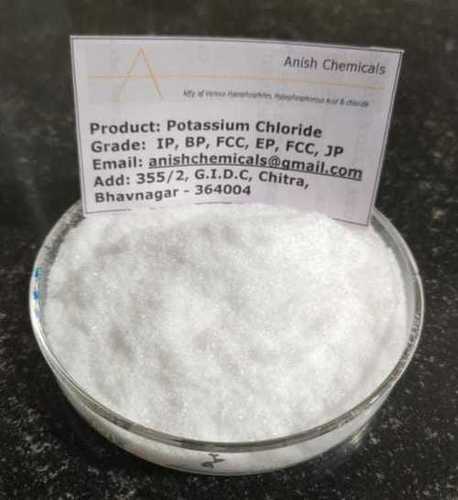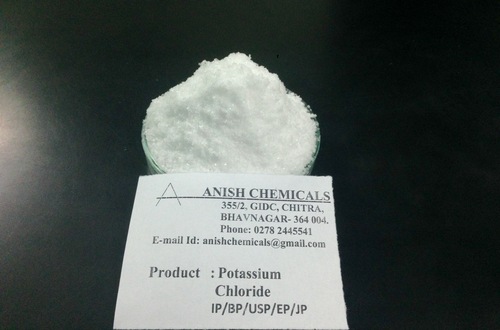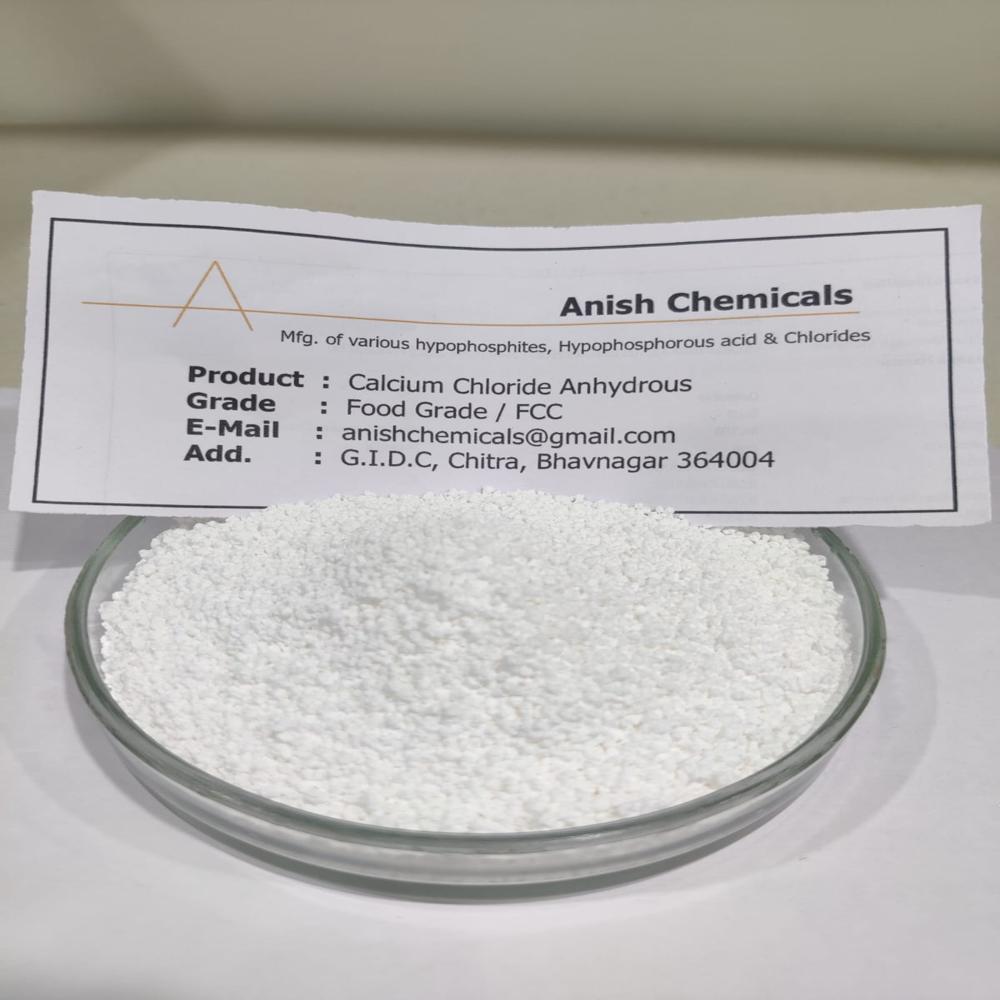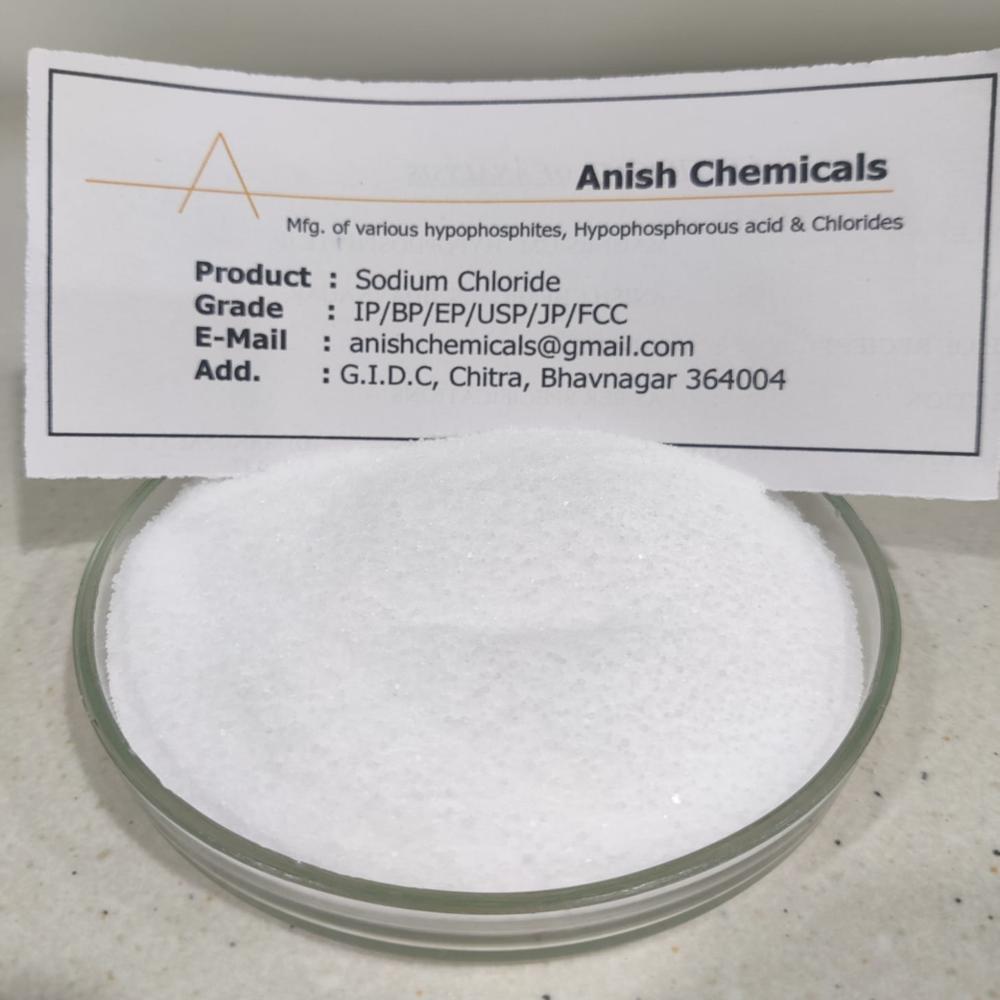





Sodium Chloride
Product Details:
- Shape Crystal
- Molecular Weight approx. 58.44 g/mol Grams (g)
- HS Code 2501 0010
- Structural Formula NaCl
- Appearance white
- Purity 99.5%
- Molecular Formula NaCl
- Click to view more
Sodium Chloride Price And Quantity
- 1 Kilograms
- 1.0 INR/Kilograms
Sodium Chloride Product Specifications
- water and slightly more soluble in boiling water
- EP, USP, BP, IP
- 7647-14-5
- Salt, Table salt, Saline
- Solid
- 99.5%
- white
- NaCl
- Salty
- 231-598-3
- NaCl
- approx. 58.44 g/mol Grams (g)
- Crystal
- 2501 0010
Sodium Chloride Trade Information
- Cash Advance (CA)
- 25 KG HD HDPE Woven bags with inner liner LDPE Liner 50 KG HD HDPE Woven bags with inner liner LDPE Liner 25 KG DR HDPE Drum with inner liner LDPE Liner 50 KG DR HDPE Drum with inner liner LDPE Liner 25 KG KD Kraft Paper Drum with inner LDPE Liner 50 KG KD Kraft Paper Drum with inner LDPE Liner 25 KG 3P 3 Ply Paper bag with inner LDPE Liner 25 KG KH Kraft Paper laminated HDPE Bag with Liner LDPE Liner
- All India
- Production certified according to Local GMP, FSSC22000, ISO 9001:2015, Halal & Kosher
Product Description
Sodium chloride (NaCl), commonly known as table salt, is widely used in medicine, food production, and industrial processes.
Applications / Uses
Flavor enhancer: A fundamental ingredient used to season and enhance the natural flavors of a wide variety of foods.
Preservative: Inhibits the growth of bacteria and other microorganisms by drawing out moisture through osmosis, which is especially useful for preserving meats, fish, and vegetables.
Processing aid: Plays a role in baking by regulating yeast fermentation, affecting the texture of dough, and improving the overall structure of baked goods.
Essential nutrient: It is a necessary part of the human diet.
Isotonic saline solutions: Used to create solutions like IV drips that have the same salt concentration as bodily fluids, which is crucial for rehydrating patients or administering medications.
Excipient and filler: Acts as a filler or stabilizer in tablet and capsule formulations.
Preparation: Used in the preparation of solutions for various applications, such as those used in contact lens care.
Dehydration prevention: Helps prevent dehydration in patients when administered orally or intravenously.
Dietary Information : The product is suitable for the following nutrition:
Kosher, Halal, Vegetarian, Vegan
Allergen Free, GMO Free, Irradiation Free,
Specifications
|
Grade |
IP |
BP |
EP |
USP |
JP |
FCC |
|
Description |
Colourless crystals or white, crystalline powder |
White or almost white crystalline powder or colourless crystals or white or almost white pearls |
White or almost white crystalline powder or colourless crystals or white or almost white pearls |
Colourless cubic crystals or white crystalline powder, has a saline taste |
Colourless or White, Crystals or Crystalline Powder |
opaque, white crystalline solid of variable particle size |
|
Identification |
Gives reactions of Sodium & of chlorides |
Gives reactions of chlorides & Sodium |
Gives reactions of Sodium & of Chlorides |
Gives reactions of Sodium & of chlorides |
A (1 in 20) solution gives the reactions of Sodium salts and Chlorides |
A sample gives positive tests for Sodium and for Chloride |
|
Solubility |
Freely soluble in water, slightly more soluble in boiling water, practically insoluble in ethanol |
Freely soluble in water, practically insoluble in anhydrous ethanol |
Freely soluble in water, practically insoluble in anhydrous ethanol |
Freely soluble in water, slightly more soluble in boiling water, soluble in glycerine, slightly soluble in alcohol |
Freely soluble in water, and Practically insoluble in ethanol (99.5) |
One gram is soluble in 2.8 mL of water at 25, in 2.7 mL of boiling water, and in about 10 mL of glycerine |
|
Clarity and Colour of Solution |
Clear & colourless |
Clear & Colourless |
Clear & Colourless |
Clear & colourless |
Clear & colourless |
- |
|
Alkalinity/Acidity |
0.5 ml of 0.01 M HCl/ 0.5 ml of 0.01 M NaOH |
0.5 ml of 0.01 M HCl/ 0.5 ml of 0.01 M NaOH |
0.5 ml of 0.01 M HCl/ 0.5 ml of 0.01 M NaOH |
0.5 ml of 0.01 M HCl/ 0.5 ml of 0.01 M NaOH |
Conforms to the test |
- |
|
Sulphates |
NMT 300 ppm |
NMT 200 ppm |
NMT 200 ppm |
NMT.200 ppm |
Any turbidity produced is not more than in the control solution |
- |
|
Iron |
NMT 20 ppm |
NMT 2 ppm |
NMT 2 ppm |
NMT. 2 ppm |
The test solution does not have more colour than the control solution |
NMT.0.016% |
|
Barium |
No turbidity is produced within 2 hrs |
The opalescence in the test solution is not more intense than the standard solution after 2 hrs |
Any opalescence in the test solution is not more intense than the standard solution |
Any opalescence in the test solution is not more intense than that in the reference solution |
The test solution is not more turbid than the Control solution |
- |
|
Iodide |
No blue colour after 5 mins |
No blue colour |
No blue colour |
No blue colour after 5 mins |
No blue colour after 5 mins |
NMT 0.010% |
|
Bromide |
NMT 0.1 % |
NMT 100 ppm |
NMT 100 ppm |
NMT. 100 ppm |
The Absorbance at 590 nm of the test Solution is not more than that the Standard solution |
- |
|
Calcium & Magnesium |
NMT 50 ppm |
NMT 100 ppm |
NMT 100 ppm |
NMT. 100 ppm |
Should comply to the test |
NMT 0.35% |
|
Heavy Metals |
NMT 5 ppm |
- |
NMT 5 ppm |
- |
NMT. 3 ppm |
NMT. 2 mg/kg |
|
Arsenic |
NMT 1 ppm |
NMT 1 ppm |
NMT 1 ppm |
NMT 1 ppm |
NMT 2 ppm |
NMT. 1 mg/kg |
|
Aluminium |
NMT 0.2 ppm |
NMT 0.2 ppm |
NMT 0.2 ppm |
NMT 0.2 ppm |
- |
- |
|
Potassium |
NMT 0.1% |
NMT 500 ppm |
NMT. 500 ppm |
NMT. 500 ppm |
- |
- |
|
Ferrocyanide |
No blue colour is produced within 10 mins |
No blue colour is produced within 10 mins |
No blue colour develops within 10 mins |
No blue colour develops within 10 mins |
No blue colour is produced within 10 mins |
No Blue Colour |
|
Nitrites |
- |
The absorbance is not greater than 0.01 at 354 nm |
The absorbance is not greater than 0.01 at 354 nm |
The absorbance is not greater than 0.01 at 354 nm |
- |
- |
|
Phosphate |
- |
NMT 25 ppm |
NMT 25 ppm |
NMT 25 ppm |
The colour of the test solution is not darker than the control solution |
- |
|
Bacterial Endotoxins |
- |
Less than 5 IU/g |
Less than 5 IU/g |
Less than 5 IU/g |
- |
- |
|
Loss on drying |
NMT 1.0% @ 105oC for 3 hrs |
NMT 0.5 % @ 105oC for 2 hrs |
NMT 0.5 % @ 105oC for 2 hrs |
NMT 0.5% @ 105oC for 2 hrs |
NMT 0.5% @ 105oC for 2 hrs |
NMT 0.5% @ 110oC for 2 hrs |
|
Assay Dry Basis |
99.0 % to 100.5 % |
99.0 % to 100.5 % |
99.0 % to 100.5 % |
99.0 % to 100.5 % |
99.0 % to 100.5 % |
99.0 % to 100.5 % |

Price:
- 50
- 100
- 200
- 250
- 500
- 1000+


